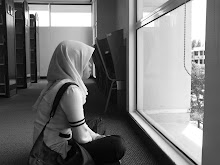|
Uncommon
Sense
|
|
IRWAN ABDUL RAHMAN
FOR a place we all visit to conduct the most
important "business" of the day, the toilet sure doesn’t get the
respect it deserves.
How many times have we gone into a public
toilet, at rest areas, petrol stations, restaurants or even hotels, and
caught ourselves letting out a quiet, angry but helpless yelp, upon seeing –
or worse, coming into contact with – some other people’s toxic waste?
I bet we’ve all experienced it: Having to
gingerly hose the leftover doo-doo down the hole or wipe the golden grime off
the seat, and having to do so while our bladder or belly is impatiently
screaming for the signal to discharge.
It’s an unmentionable torture we go through
just for a relief, a necessary ritual before the Great Escape.
It’s probably no longer a big deal now,
having heard the same complaint over and over again. We’ve grown so used to
it, as if dirty toilets are a charming part of the Malaysian culture for
tourists to discover.
Bad toilet habits and even worse toilet conditions
are a dime a dozen in Malaysia, despite all the cleanliness campaigns and
calls for better enforcement. Our expectations of public lavatories are so
low, that finding a clean, pleasant-smelling and fully-functional toilet
would be the highlight of the day, an exciting anecdote we share with our
loved ones over dinner after a long, hard day.
Why is it so hard to maintain a hygienic and
fully functioning toilet here? Why is finding the unflushed bowl
"normal"?
A leadership guru once said, “The best way
to judge a person or a company is actually by visiting their lavatory. It is
a reflection of their most personal values. If they take good care of the
seemingly most insignificant room on their premises, then they’d take good
care of the more important things.”
Treating the toilet with respect, despite
its lowly function as a place where you dump all the dirty things in life,
reflects how one would treat himself and other people, and on a greater
scale, how civilised we are as a society.
So what does that say about us Malaysians in
general?
Many companies have started realising the
importance of maintaining a good lavatory and how it reflects on their brand.
In fact, they’ve realised the atmosphere in their premises not only affects
the morale of their employees, it also affects their brand in the eyes of
their clients, vendors and visitors.
This is even more so for service industries
such as restaurants and hotels, who invest quite a bit on making sure their
lavatories are properly maintained and beautifully decorated (PLUS highway’s
many newly refurbished toilets in the rest areas are an example — they look
like gardens of Eden with their open air concept, green landscape and
generous space!).
To illustrate how toilets affect business,
imagine yourself picking a mall to shop in or take your family this weekend —
would you choose the one which you know has poorly kept toilets?
Naturally, the responsibility of ensuring
cleanliness of public toilets mainly fall upon the premises owners, who
should invest in the best quality appliances and fixtures (so that they would
last long and resist the daily usage and abuse of so many patrons),
perishables (hand soap, toilet paper, paper towels, toilet cleaning and water
supplies) and manpower to keep the restrooms in tip-top condition.
But the duty also falls on the laps of users
themselves — the public, who in a supposedly civilised society like ours,
SHOULD know how to behave in a toilet. I used the term ‘should’, because I
think we can all agree that at current, we’re not behaving as we should.
Many of us still cannot tell the difference
between the floor-based ‘squatting type’ toilet bowls with the elevated ‘seat
type’. If not, we would not be discovering shoe prints on the toilet seat! It
must have been a real acrobatic act, balancing themselves as they squat on
the elevated 'throne' in such confined spaces — all while trying to answer
nature’s call.
It’s absolutely disgusting finding yellow
stains all over the place, particularly on the toilet seat which is supposed
to come into contact with our skin (which probably explains the problem of
people squatting on the elevated seats).
This issue, as can be expected, isn’t
limited to only the fellas of course, judging by the stuff I’ve heard my wife
and female friends have relayed to me. Women’s restrooms do also have their
bag of problems, but let’s not get into the gory details – that wouldn’t be
ladylike (Girls are supposed to be all sugar and spice, and everything nice
anyhow, no?).
Ultimately, toilets and washrooms are places
that should be some of the most comfortable rooms to be in. The toilet, from
bathroom types to the small cubicle, is a place where a person is at his most
honest with himself. It is his most basic, most private comfort zone and when
he is at his most vulnerable.
|
Friday, August 3, 2012
Subscribe to:
Post Comments (Atom)

No comments:
Post a Comment